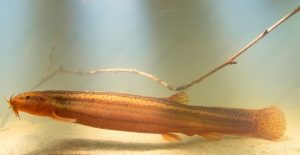The Roseline Shark, or the Denison Barb or Red Line Torpedo Barb, is a well-loved fish among enthusiasts. Its striking colours and lively nature often make it the focal point of aquarium displays.
This guide will delve into all aspects of the Roseline Shark, covering its habitat care needs and more.

Physical Characteristics
Size and Appearance
Roseline Sharks can reach lengths of up to 6 inches. These fish are known for their torpedo-shaped bodies, a red line that extends from their nose through their eye to the centre of their body and a vibrant yellow and black stripe that runs along the length of their body.
Distinguishing Features
- Red Line: The most striking feature is the red line that runs horizontally from the nose to the midsection.
- Caudal Fin: Their tail fin is forked and adorned with a splash of red.
- Coloration: They have a silvery body with a greenish hue on the dorsal side.
Behavior and Temperament

Social Structure
Roseline Sharks tend to stick in groups of six or more as they enjoy the company of others. They are known for their peaceful nature. Thrive well when kept in communal aquariums.
Compatibility with Other Fish
They are compatible with other peaceful species but can be stressed by aggressive tank mates. Good companions include Tetras, Rasboras, Gouramis and other peaceful fish of similar size.
Feeding the Roseline Shark
Diet in the Wild
In their natural habitat, Roseline Sharks are omnivores. They feed on a variety of invertebrates, plant matter, and algae.
Recommended Diet in Captivity
A balanced diet in an aquarium should include:
- High-quality flake food: As a staple
- Frozen or live food: Such as brine shrimp, daphnia, and bloodworms
- Vegetables: Blanched spinach or zucchini to ensure they get enough plant matter
Common Health Issues
Signs of Disease
Common signs of health issues include:
- Loss of appetite
- Unusual swimming patterns
- Visible spots or lesions
Prevention and Treatment
- Quarantine New Fish: Always quarantine new fish before introducing them to the main tank.
- Maintain Water Quality: Regular water changes and tank maintenance are crucial.
- Medications: Use appropriate medications for treating specific diseases like Ich or fin rot.
Aquascaping for Roseline Sharks

Plant Recommendations
- Java Fern
- Anubias
- Hornwort
These plants can withstand the activity of Roseline Sharks and thrive in similar water conditions.
Ideal Tank Decorations
- Rocks and Driftwood: Provide hiding spots and mimic their natural habitat.
- Open Swimming Areas: Ensure there is ample open space for swimming.
Buying a Roseline Shark
What to Look For in a Healthy Roseline Shark
- Bright coloration
- Active swimming behavior
- Clear eyes and intact fins
Roseline Sharks and Cichlids: Compatibility Considerations
Behavioral Differences
- Roseline Sharks: Peaceful, schooling fish that prefer to live in groups. They are active swimmers and thrive in a calm community tank environment.
- Cichlids: Behavior can vary widely among species. Some cichlids are aggressive and territorial, which can lead to conflicts in a shared tank.
Tank Environment
- Roseline Sharks: Prefer a well-planted tank with plenty of swimming space and hiding spots. They thrive in clean, well-oxygenated water with moderate to high flow.
- Cichlids: Depending on the species, cichlids can be aggressive towards other fish, particularly during breeding or when establishing territory. They may also disrupt planted tanks by digging or rearranging the substrate.
Cichlid Species to Avoid
- Aggressive Species: Avoid species like African cichlids (e.g., Mbuna, Peacock cichlids) that are known for their aggression and territorial behavior.
- Large Predatory Cichlids: Avoid larger species that might view Roseline Sharks as prey or exhibit bullying behavior.
Potential Exceptions
- Dwarf Cichlids: Some dwarf cichlids, such as Apistogramma or Bolivian Rams, are more peaceful and might coexist with Roseline Sharks in a well-managed tank. However, close monitoring is essential.
FAQs
1. How big do Roseline Sharks get?
- They can grow up to 6 inches in length.
2. Are Roseline Sharks aggressive?
- No, they are generally peaceful and do well in community tanks.
3. What do Roseline Sharks eat?
- They are omnivores and eat a mix of flake food, live or frozen food, and vegetables.
4. How many Roseline Sharks should be kept together?
- They are schooling fish and should be kept in groups of six or more.
5. Can Roseline Sharks live with Cichlids?
- They should not be kept with aggressive Cichlids, as they may be bullied or stressed.
6. Can Denison Barb live alone?
- No, they are schooling fish and should be kept in groups.
Recommended Reading: Beyond Bubbles: The Surprising Intelligence Of Fish



